INDIAN ARMED FORCES CHIEFS ON OUR RELENTLESS AND FOCUSED PUBLISHING EFFORTS

The insightful articles, inspiring narrations and analytical perspectives presented by the Editorial Team, establish an alluring connect with the reader. My compliments and best wishes to SP Guide Publications.

"Over the past 60 years, the growth of SP Guide Publications has mirrored the rising stature of Indian Navy. Its well-researched and informative magazines on Defence and Aerospace sector have served to shape an educated opinion of our military personnel, policy makers and the public alike. I wish SP's Publication team continued success, fair winds and following seas in all future endeavour!"

Since, its inception in 1964, SP Guide Publications has consistently demonstrated commitment to high-quality journalism in the aerospace and defence sectors, earning a well-deserved reputation as Asia's largest media house in this domain. I wish SP Guide Publications continued success in its pursuit of excellence.
- Prime Minister Modi Visits Punjab’s Adampur Air Base, Interacts with Airmen after Successful ‘Operation Sindoor’; Stern Message to Pakistan
- The layered Air Defence systems that worked superbly, the key element of Operation Sindoor
- Operation Sindoor | Day 2 DGMOs Briefing
- Operation Sindoor: Resolute yet Restrained
- India's Operation Sindoor Sends a Clear Message to Terror and the World – ‘ZERO TOLERANCE’
- Japan and India set forth a defence cooperation consultancy framework, talks on tank and jet engines
Sneak Peek into the heart of our galactic home
On May 12, 2022 astronomers unveiled the first image of the supermassive black hole at the centre of our own Milky Way galaxy, Sagittarius A*.
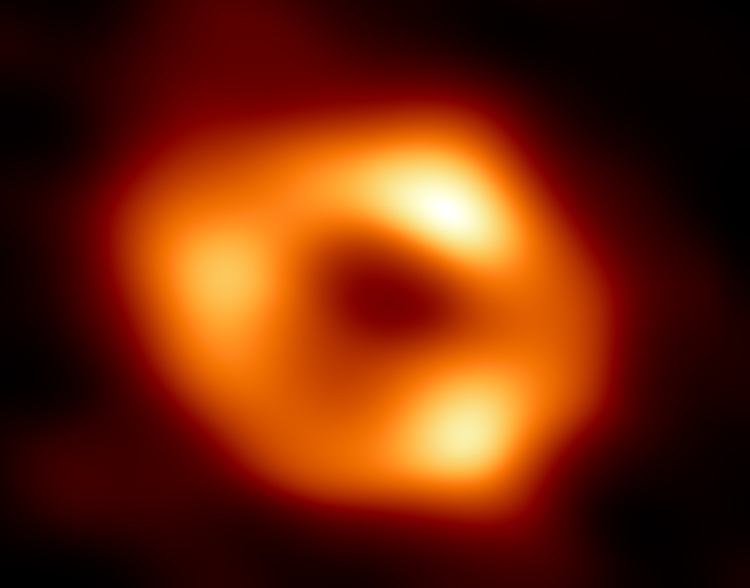
It is a super exciting time for space science and exploration as we continue getting farther and farther into the universe. In another spectacular display of what a collaboration of science, engineering, operations, and vision can do, on May 12, 2022, at six simultaneous press conferences around the world, astronomers unveiled the first image of the supermassive black hole at the centre of our own Milky Way galaxy, Sagittarius A*.
Scientists had previously seen stars orbiting around something invisible, compact, and very massive at the centre of the Milky Way. This strongly suggested that this object — known as Sagittarius A* (Sgr A*) — is a black hole, and now the image provides the first direct visual evidence of it.
The image does not distinctly show the black hole itself, because it is completely dark, glowing gas around it reveals a telltale signature: a dark central region (called a shadow) surrounded by a bright ring-like structure.
Although the image does not distinctly show the black hole itself, because it is completely dark, glowing gas around it reveals a telltale signature - a dark central region (called a shadow) surrounded by a bright ring-like structure. This black hole is four million times more massive than our Sun.
“We were stunned by how well the size of the ring agreed with predictions from Einstein’s Theory of General Relativity. These unprecedented observations have greatly improved our understanding of what happens at the very centre of our galaxy, and offer new insights on how these giant black holes interact with their surroundings," said Event Horizon Telescope (EHT) Project Scientist Geoffrey Bower from the Institute of Astronomy and Astrophysics, Academia Sinica, Taipei.
Capturing the Image
The image was produced by a global research team called the Event Horizon Telescope (EHT) Collaboration, using observations from a worldwide network of radio telescopes. The EHT achievement follows the collaboration’s 2019 release of the first image of a black hole, called M87*, at the centre of the more distant Messier 87 galaxy. Being about 27 000 light-years away from Earth, the black hole appears to us to have about the same size in the sky as a doughnut on the Moon. To image it, the team created the powerful EHT, which linked together eight existing radio observatories across the planet to form a single “Earth-sized” virtual telescope. The EHT observed Sgr A* on multiple nights in 2017, collecting data for many hours in a row, similar to using a long exposure time on a camera.
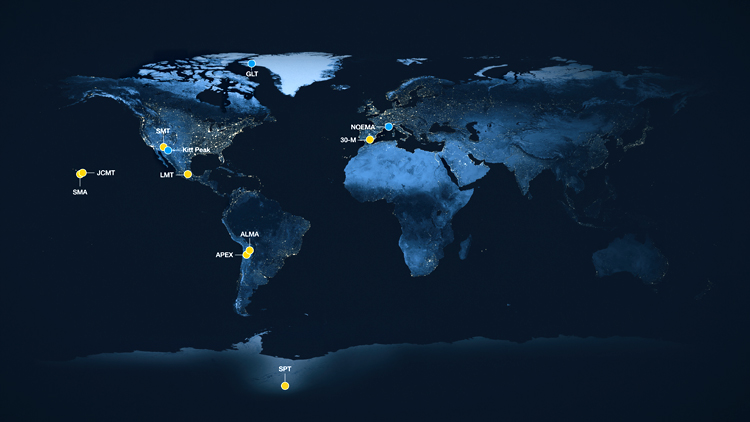
More than 300 researchers from 80 institutes from around the world that together make up the EHT Collaboration worked rigorously for five years, using supercomputers to combine and analyse data that was collected, all while compiling an unprecedented library of simulated black holes to compare with the observations. The amount of large terabytes of data collected is so huge that if you were to paper stack, it would reach the moon.
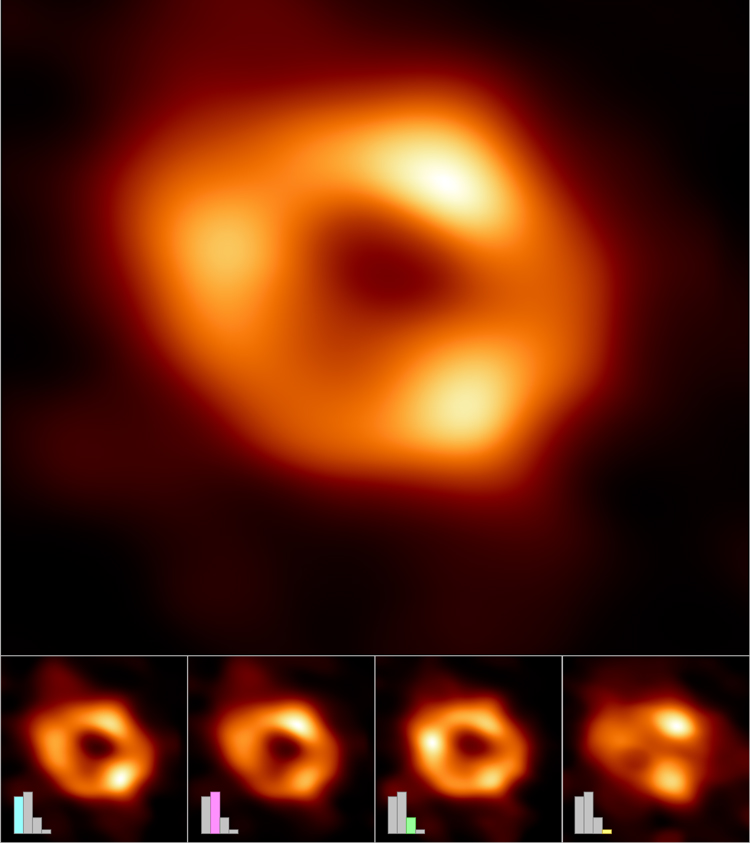
The EHT Collaboration has created a single image (top frame) of Sgr A* by combining images extracted from the EHT observations. The main image was produced by averaging together thousands of images created using different computational methods — all of which accurately fit the EHT data. This averaged image retains features more commonly seen in the varied images, and suppresses features that appear infrequently.
SgrA* is about four million times more massive than our Sun and about 27000 light years away from the earth.
The images were also clustered into four groups based on similar features. An averaged, representative image for each of the four clusters is shown in the bottom row. Three of the clusters show a ring structure but, with differently distributed brightness around the ring. The fourth cluster contains images that also fit the data but do not appear ring-like. The bar graphs show the relative number of images belonging to each cluster. Thousands of images fell into each of the first three clusters, while the fourth and smallest cluster contains only hundreds of images. The heights of the bars indicate the relative "weights," or contributions, of each cluster to the averaged image at top.
The final image obtained is hence an average from all these thousands of images that were captured and observed over the years.
M87* and SgrA*
The two black holes look remarkably similar, even though our galaxy, Milky Way’s black hole is more than a thousand times smaller and less massive than M87*. "We have two completely different types of galaxies and two very different black hole masses, but close to the edge of these black holes they look amazingly similar. This tells us that General Relativity governs these objects up close, and any differences we see further away must be due to differences in the material that surrounds the black holes,” says Sera Markoff, Co-Chair of the EHT Science Council and a professor of theoretical astrophysics at the University of Amsterdam, the Netherlands.
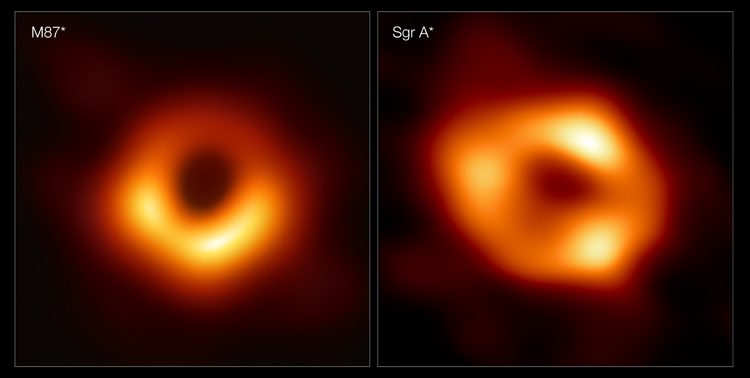
M87* is more than a thousand times larger than the black hole at the centre of our galaxy, Sgr A*, which means that the gas goes around the latter much faster (on the timescale of minutes) than it goes around the former (on the timescale of days to weeks). It made this achievement considerably more difficult than for M87*, even though Sgr A* is much closer. EHT scientist Chi-kwan Chan, from Steward Observatory and Department of Astronomy and the Data Science Institute of the University of Arizona, USA, explained, “The gas in the vicinity of the black holes moves at the same speed — nearly as fast as light — around both Sgr A* and M87*. But where gas takes days to weeks to orbit the larger M87*, in the much smaller Sgr A* it completes an orbit in mere minutes. This means the brightness and pattern of the gas around Sgr A* were changing rapidly as the EHT Collaboration was observing it — a bit like trying to take a clear picture of a puppy quickly chasing its tail.”
The EHT achievement follows the collaboration’s 2019 release of the first image of a black hole, called M87*, at the centre of the more distant Messier 87 galaxy.
The researchers had to develop sophisticated new tools that accounted for the gas movement around Sgr A*. While M87* was an easier, steadier target, with nearly all images looking the same, that was not the case for Sgr A*. The image of the Sgr A* black hole is an average of the different images the team extracted, finally revealing the giant lurking at the centre of our galaxy for the first time.
M87 is 55 million light-years away in the Virgo Galaxy cluster and has a mass about 6.5 billion times that of our sun. It takes many days to orbit around this gargantuan object. That means that when the EHT team shines their telescopes on it for hours — using a technique called very long baseline interferometry that works like taking a long exposure image on a camera — any change appears very gradually.
While Sgr A* is on the small side,if it was the size of a doughnut, M87 would be the size of a football stadium, said Sara Issaoun NASA Einstein Fellow at the CfA who worked on observations and imaging for the EHT team. This means superheated gas, which travels at near-light speed and takes days to orbit M87, only takes minutes to orbit Sgr A*, which is why there is so much motion blur in the image. In addition, there is a giant cloud of ionized gas between Earth and the Galactic Center, which distorts the images the EHT takes of Sgr A,* which sits in central region of the Milky Way. It’s like looking at something through frosted glass, said Daniel Palumbo, a Harvard graduate student at the CfA who worked on the data analysis.
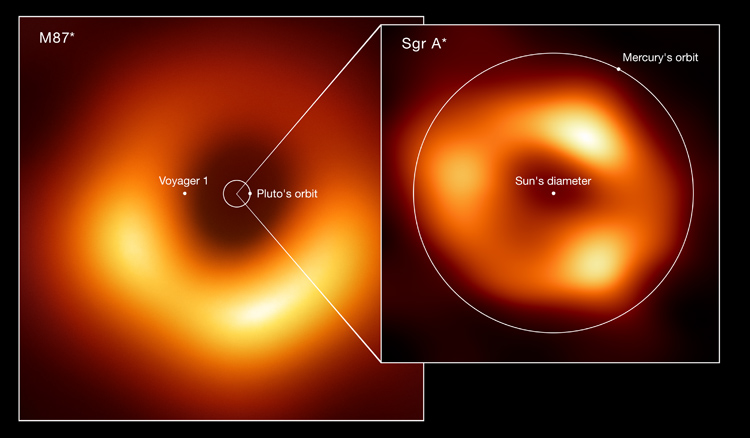
The two images can now be compared to gain valuable insight on the inner workings of these supermassive giants and how they interact with their surroundings, a process thought to play a key role in shaping the formation and evolution of galaxies. “We have images for two black holes — one at the large end and one at the small end of supermassive black holes in the Universe — so we can go a lot further in testing how gravity behaves in these extreme environments than ever before,” Taipei added.
WHAT NEXT
Progress on the EHT continues, a major observation campaign in March 2022 included more telescopes than ever before. The ongoing expansion of the EHT network and significant technological upgrades will allow scientists to share even more impressive images as well as movies of black holes in the near future. That there now exist images of two black holes of very different sizes is particularly exciting to the astronomers, and they have already begun to use the new data to test theories and models of how gas behaves around supermassive black holes.
More than 300 researchers from 80 institutes from around the world have worked together through years to present the image.
“With the interdisciplinary expertise at the Smithsonian, Harvard, and the Center for Astrophysics, our large group here has become the center of gravity for this visionary project, and an incubator for discoveries over the next decade,” said CfA scientist Sheperd Doeleman, Founding Director of the EHT and Co-Director of the Black Hole Initiative.
The work of studying these giants is far from finished. The members of the group say they are now looking at a next-generation EHT (ngEHT) project - capturing video of a black hole. The project will involve designing new ultra-high-speed instrumentation and a plan to double the number of radio dishes in the EHT array that will allow scientists “to create an Earth-sized motion picture camera” that “will bring black holes to vibrant life,” said Doeleman, who also leads the ngEHT project.
The James Webb Telescope that has now aligned at its position following its December launch
From obtaining a labeled map of our galaxy’s center to the first image of the supermassive black hole at its centre, we have come a long way and there is still a lot that awaits to be discovered.





